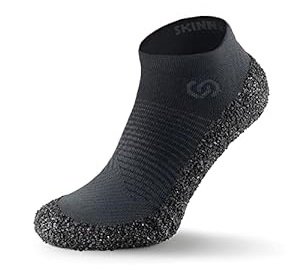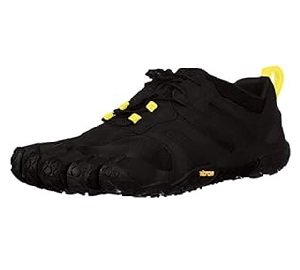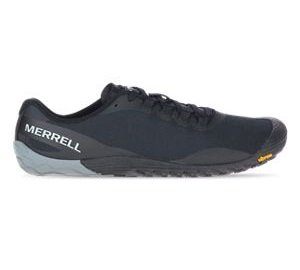The Best Barefoot Hiking Shoes of 2024
In the heart of nature, every step becomes a dance between you and the terrain beneath your feet. Anyone who has ever enjoyed barefoot shoes will no longer want to be without them, not even when hiking. They offer a smooth feeling of walking and the toe gains freedom, not like readily traded bulky or stiff boots.
This year’s selection of the best barefoot hiking shoes embodies the perfect fusion of comfort, durability, and sensory connection. From the rugged slopes of the Rocky Mountains to the lush trails of the Pacific Northwest, we have carefully organized a list of the finest barefoot hiking shoes to accompany you on your outdoor journeys.
So, lace up, and let’s set out on a barefoot adventure like never before.
Best barefoot hiking shoes of 2024
Take a look at our comparison table of the 5 best barefoot hiking shoes of 2024.
| Image | Name | Sole | Weight | Price |
| VIVOBAREFOOT Tracker II | Firm Ground | 11.6 oz. | Check | |
 | Skinner’s 2.0 Hybrid Sock | Rubber | 5.64 oz. | Check |
 | Vibram Five Fingers V-Trail | Rubber | 6.4 oz. | Check |
 | Merrell Vapor Glove 4 | Vibram | 1 lb | Check |
| Vivobarefoot Tracker Forest Esc | Firm Ground | 1.2 lbs | Check |
- 1. VIVOBAREFOOT Tracker II – Best barefoot shoes for hiking with a high shaft
- 2. Skinner’s 2.0 Hybrid Sock – Best barefoot shoes for short hikes
- 3. Vibram Five Fingers V-Trail Running Shoes – Best toe shoes for hiking
- 4. Merrell Vapor Glove 4 Trekking Shoes – Best low-cut barefoot hiking shoe
- 5. Vivobarefoot Esc Tracker Forest – Best sturdy barefoot shoes for hiking
1. VIVOBAREFOOT Tracker II
Specs:
- Material: Leather, Textile
- Sole: Firm Ground Sole
- Closure: Lacing
- Shoe Width: Wide
- Size: Available
The VIVOBAREFOOT Tracker II barefoot shoes are designed to deliver a natural and minimalist footwear experience. Featuring a waterproof and breathable membrane, these shoes keep your feet dry even in challenging conditions. With a removable thermal sole, they are well-suited for the cold season, ensuring your feet stay warm and comfortable.
The Tracker II features a firm ground (FG) outsole, specifically engineered for diverse natural terrains such as trails, grass, and rocky surfaces. This type of outsole is designed to offer exceptional grip and durability.
These are lightweight and provide excellent support in the heel area while offering ample space for the toes in the front section. Despite being robust due to its stiffer sole, it doesn’t fully replicate the classic barefoot shoe experience. This model is well-suited for beginner hikers because of its stiffer construction and high shaft.
Pros
- Waterproof and versatile
- Suitable for narrow feet
- Removable thermal sole
- Stable eyelets and laces
- Very easy to wear
Cons
- Turns out small
- Sole is glued
- Stiff sole
2. Skinner’s 2.0 Hybrid Sock Shoes
Skinners 2.0 serves as the successor to the renowned Skinners shoe socks. These barefoot socks feature a non-slip coating on the sole, ensuring stability and traction. They offer comprehensive protection for the sole of the foot and the toes and sides, making them ideal for navigating rocky terrain.
They provide excellent abrasion resistance and long-lasting durability, making them a reliable choice for outdoor activities. The outsole, crafted from top-tier Swedish polymers, ensures a crumble-free grip and provides your feet with exceptional traction.
Due to the low weight, changing shoes can be packed in the backpack without extreme additional load. It could be a light alternative to classic trekking shoes with a non-slip coating. And with a little practice, Skinners 2.0 barefoot shoe can also be used for longer hikes.
Cleaning Skinners Hyprit Sock is convenient and can be easily washed in the washing machine. We recommend these socks for individuals with some hiking experience. However, they may not be suitable for long hikes due to their full foot freedom, requiring your muscles to maintain balance throughout the trek.
Pros
- Structured like a sock
- Ultralight and portable
- Good value for the money
- Rubber sole for perfect grip
- Machine washable
Cons
- Not suitable for beginner hikers
- Order one size larger
- Rapid odor development
3. Vibram Five Fingers V-Trail
The V-Trail 2 is equipped with cutting-edge features for effortless trail conquests. It incorporates advanced lamination around the toes to thwart seam splitting. It also features 3D Cocoon mesh seamlessly into the outsole, ensuring defense against rugged elements such as rocks, roots, and acorns during outdoor training.
The V-Trail barefoot hiking shoes are suitable for trail running and convincing with their good fit. The Vibram sole ensures a firm grip on any surface and the quick-release fastener ensures that the shoe fits snugly on the foot.
The design is impressive and exceptionally robust. They are available in both women’s and men’s models, with the main difference being the shoe width to accommodate different foot sizes.
This model is also suitable for casual cycling. While you can wear insoles with the Five Fingers shoes, doing so can diminish the essence of barefoot shoes as it reduces the sensitivity to the ground.
Pros
- Simple to wear
- Toe separation provides ample mobility
- Good fit with quick release
- Vibram sole provides good grips
Cons
- The separation between toes can chafe
- Require a bit of practice to put on comfortably
4. Merrell Vapor Glove 4 Trekking Shoes
From day trips to long hikes, the Merrell Vapor Glove 4 can be the best choice for supporting your next outdoor excursion. They impress us with their lightweight design and additional toe protection which protects against bumps and debris. The structured Vibram sole ensures a good grip on straight to rough terrain.
The mesh fabric is breathable and quick-drying. The Merrell Vapor Glove 4 shoe is well-suited for short and intensive hikes. Since it is not waterproof, it can be used primarily in good weather.
The half-cut trekking shoe is also well suited for tours in summer due to its low weight. The sole, which goes beyond the toes, protects them well. The thin sole gives you a good feel of the ground when running. However, to ensure a good fit, make sure to choose one size larger.
Pros
- Rubber toe cap
- Breathable and slim
- No animal ingredients
- Very stable sole
- Versatile
Cons
- Not waterproof
- Slight heel of 1 cm
5. Vivobarefoot Tracker Forest Esc
Specs:
- Material: Leather, Textile
- Sole: Firm Ground Sole
- Closure: Lacing
- Shoe Width: Wide
- Size: Available
The Vivobarefoot Tracker Forest Esc barefoot hiking shoes, featuring a sewn sole and riveted lace eyelets, are incredibly durable and robust, making them suitable for long tours. They are designed to offer optimal grip and traction on uneven and natural surfaces, enhancing stability and boosting confidence during hiking.
These trekking shoes are breathable thanks to a special mesh lining and thus ensure a dry feeling in the shoes. The outside is water-repellent due to the processed leather. This will keep your feet dry if you take good care of them. The 3 mm thick sole is puncture-resistant and offers good grips on any surface.
This model includes a removable OrthoLite insole, offering additional insulation during colder weather and can be taken out for increased breathability in warmer conditions. With high-quality sewn and leather construction, the Tracker Forest Esc is well-crafted and provides long-lasting performance.
Pros
- Stitched sole
- Water repellent
- Stable and non-slip
- Flexible and foldable
- Extra insole for cold days
Cons
- Difficult to wear
- Not for narrow feet
- Stiff
What to Consider When Buying Barefoot Shoes for Hiking?
Before buying the best barefoot hiking shoes, the following characteristics should be considered:
Type of barefoot shoes
Barefoot shoes come in various types, each designed to provide a barefoot-like experience while offering some level of protection and support. The main types of barefoot shoes include:
- Running Shoes: These are specifically designed for running and often feature a thin sole, minimal cushioning, and a wide toe box to allow for natural toe splay and foot movement.
- Casual Shoes: These are everyday shoes that mimic the feel of walking barefoot. They may have a flexible sole, zero drop (meaning the heel is at the same height as the forefoot), and are generally lightweight and breathable.
- Trail Shoes: Similar to running shoes, trail barefoot shoes are designed for off-road running and hiking. They have a more aggressive tread pattern for traction on uneven terrain and offer additional protection against rocks and debris.
- Water Shoes: These are designed for activities in or around water, such as beach walking, kayaking, or paddleboarding. They are lightweight, quick-drying, and often have a minimal sole to provide a barefoot feel while protecting the feet.
- Sandals: Barefoot sandals feature minimalistic designs with thin soles and straps to protect while allowing the feet to move freely. They are popular for casual wear and outdoor activities during warm weather.
Shaft height
The question here is whether to choose a low or high cut. Models with a high shaft provide ankle support during extended trekking tours and hikes with heavy loads, making them particularly beneficial for beginners wearing barefoot shoes.
Material
Leather remains the classic choice of material for hiking shoes due to its positive impact on foot climate. When properly maintained, leather exhibits water-repellent, resistant, and durable properties.
Furthermore, when lined with a membrane, leather shoes become waterproof, which is crucial for long hikes where changing footwear isn’t convenient. However, for short and straightforward hikes, the water resistance aspect may be less critical and can be overlooked.
Sole Thickness
Decide on the level of sole thickness based on your preferences and the activities you plan to do. Thinner soles provide better ground feel and flexibility but offer less protection, while slightly thicker soles may offer more cushioning and durability for longer runs or rough terrain.
It is also important whether the sole is sewn or glued to the shoe. The sewn version is more robust and is an advantage, especially on long or multi-day tours.
Hiking season
Hiking with wet feet can be quite unpleasant. Therefore, protection from rain, snow, and other environmental elements is crucial, especially during trekking tours or hikes. The season also plays a significant role in this regard.
➤Winter?
If the shoes are intended for winter, then a warm layer on the sides and a thermal sole in the shoe is a good advantage. Water-repellent material is highly recommended for the cold season. This keeps your feet warm and dry even on longer tours.
➤Summer?
In summer it is important that your feet do not sweat too much and that excess moisture does not remain on the skin to prevent blisters. Breathable models are therefore a good choice. To ensure that your feet stay dry even on long hikes and multi-day tours, you can pack another pair in your backpack.
Find the right size
Ensuring ample room for your toes is a critical criterion when purchasing barefoot hiking shoes. Similar to traditional shoes, one of the most common mistakes people make when buying footwear is opting for sizes that are too small.
➤shoe length
The shoe must offer at least 1 to 2 thumb widths more space than your foot length. This extra length is needed for rolling because the bent foot is longer than when standing normally on the ground. Also, the extra length compensates for the fact that the foot becomes wider and longer when running due to blood circulation.
➤shoe width
The width is equally crucial. The foot should not rest directly on the seams of the sole but rather be framed by it. You can easily check the width on the insole of a shoe. If your foot completely covers the sole, then the shoe is too narrow for you.
What You Should Consider When Switching From Classic Hiking Shoes to Barefoot Shoes?
Is it common to walk barefoot, or are your feet typically clad in traditional shoes? If you haven’t had much experience with barefoot shoes or walking barefoot in everyday life, it’s not recommended to embark on a long hike in the mountains. Whether you’re a seasoned hiker or a beginner, individuals who have seldom or never walked barefoot, even in barefoot shoes, can strain their feet excessively.
Following these five points can facilitate your transition to barefoot shoe hiking:
- Start slowly: Gradually increase your barefoot walking or barefoot shoe usage, similar to how one approaches gym training or jogging. Slow and steady progression is key to avoid overexertion.
- Exercise your feet: Incorporate foot exercises into your routine to strengthen muscles and improve foot mobility, complementing regular barefoot walking.
- Take breaks: Rest periods are essential for recovery and muscle building. Listen to your body, and take breaks when your feet feel fatigued.
- Ensure proper fit: Allow ample space for the rolling movement of your foot by opting for shoes with toe freedom and sufficient width. The shoe should be 1 to 2 thumb widths longer than your foot.
- Allow enough preparation time: Gradually increase the intensity and duration of your barefoot activities over 1 to 3 months. Begin with short, easy walks on flat terrain before progressing to more challenging trails.
FAQs
Which barefoot shoes are suitable for hiking?
Trail barefoot shoes, designed specifically for hiking, are suitable for outdoor adventures. Brands like Vivobarefoot, Merrell, and Xero Shoes offer durable options with grippy soles, protective toe caps, and water-resistant materials. These shoes provide the necessary traction, stability, and ground feel for navigating various terrains while promoting natural foot movement and comfort during long hikes.
Are barefoot hiking shoes waterproof?
Barefoot hiking shoes can vary in their waterproofing capabilities. Some models are designed with water-resistant materials that offer limited protection against moisture, such as light rain or splashes. However, they are not fully waterproof like traditional hiking boots with Gore-Tex or similar membranes. If waterproofing is a priority for your hiking adventures, consider using waterproof socks or applying a water repellent treatment to your barefoot shoes.
How much do good barefoot shoes cost?
There are now models for less than 20 dollars, but the workmanship is rarely good and durable. High-quality products cost between 100 and 250 dollars. Seasonal offers from manufacturers also make high-quality products available at lower costs.
Are barefoot hiking shoes suitable for all types of terrain?
While barefoot hiking shoes excel on natural terrains like trails, forests, and rocky surfaces, they are not ideal for extremely rugged or technical terrain. It’s important to choose a shoe with an appropriate outsole for the specific type of hiking you plan to do.
Do barefoot hiking shoes provide enough protection for rough terrain?
While barefoot shoes offer a more minimalist experience, many models are designed with features like durable outsoles and toe protection to safeguard against rough terrain. However, make sure the shoe matches the intensity of your planned hikes.
Are barefoot hiking shoes suitable for people with foot conditions or injuries?
People with foot conditions or injuries should consult with a healthcare professional before transitioning to barefoot shoes. However, some people find benefits from the natural movement.
Final Thoughts
The market offers a diverse range of barefoot hiking shoes adapted to meet the needs of outdoor enthusiasts seeking a more natural and connected experience on the trails. By selecting your barefoot hiking shoes from our guide, you’re not just adopting a more natural way of moving but also potentially enjoying the advantages of enhanced foot strength and posture.
It’s crucial to remember that choosing the correct size is essential because only the right shoe size allows you to fully experience the benefits of barefoot shoes. If the shoe is too narrow or small, these advantages will be compromised.





